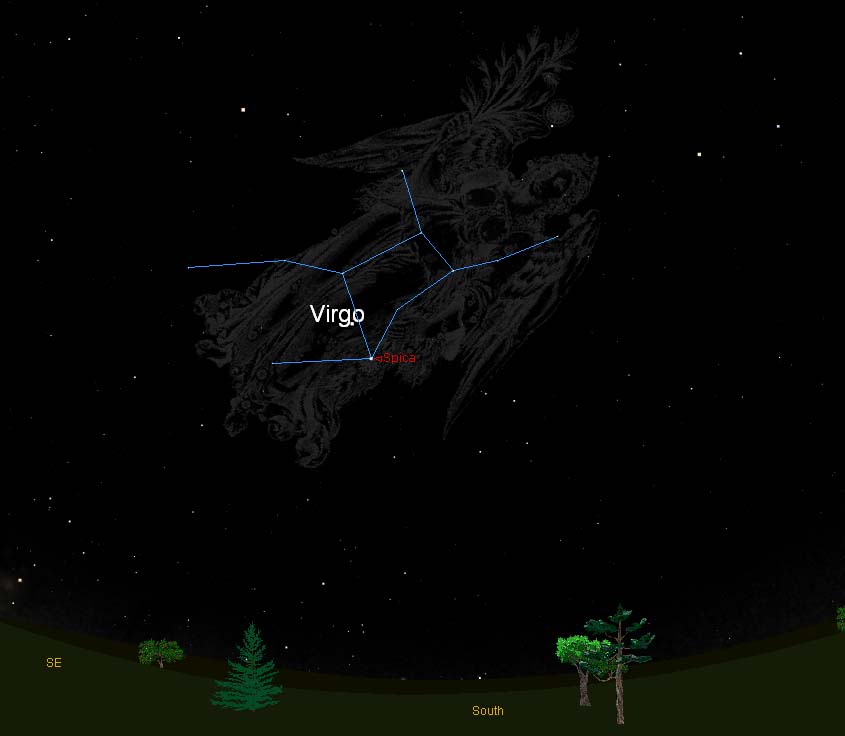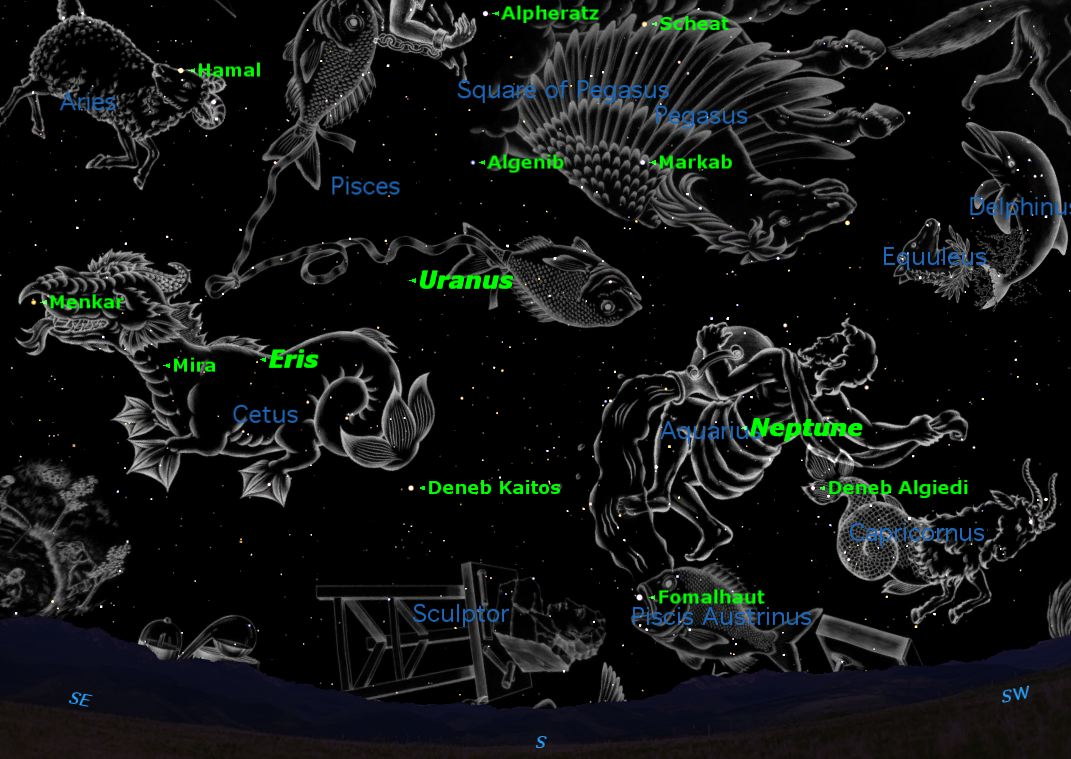See Jupiter and Virgo in the Night Sky This Month

Currently in the evening sky, the dominant planet is Jupiter, which shines brilliantly in the east to southeast as darkness falls. There is certainly no problem in finding it, even if you live within the confines of a brightly lit city. What you may not know, however, is that Jupiter is situated within the boundaries of the largest constellation in the sky: Virgo, the Virgin.
Of the 12 signs of the zodiac, there is only one feminine figure, and that is Virgo. But quite unlike Jupiter, which stands out like a night-light, the stars that compose Virgo are relatively dim. Unlike most of the constellations that date back to antiquity, Virgo presents no distinctive pattern of stars to attract much attention.
I've always traced out these stars to resemble a large letter "Y." In the old allegorical star atlases of the 17th and 18th centuries, she is more often than not portrayed as a beautiful maiden with wings, with a shawl draped around her. Holding a spike of wheat, her outstretched left hand is conspicuously marked by her brightest jewel, the bluish star Spica, Latin for "ear of grain." [Constellations of the Night Sky: Famous Star Patterns Explained]
Spica is the 16th brightest star in the sky. That certainly sounds impressive, but right now, the star has the misfortune of having Jupiter in its general vicinity. If you hold your clenched fist out at arm's length, Jupiter is positioned roughly "one fist" to Spica's upper right and outshines the star by a factor of some 23-fold.
Two and a half centuries away
And make no mistake about it, Spica is a star of formidable size and makes Earth's own sun look rather puny. In fact, Spica is seven times larger than the sun and more than 10 times as massive. It's about 250 light-years from Earth, meaning that starlight leaving Spica at the time of the signing of the Declaration of Independence will finally reach the Earth around the year 2026.
At New York's Hayden Planetarium, I've been a staff lecturer for over 30 years, but some of the orators who preceded me there are still considered legendary raconteurs of the first order. One of them was Henry Neely, who was at Hayden more than half a century ago. Of Spica, Neely would often say, "It could have been totally destroyed back in 1776, yet we would still see it shining serene and undisturbed until the babies who are now in their mothers' arms are old men and cursing the younger generation … and their rheumatism in the same breath!"
Consider this: At Spica's distance from Earth, it would require 12,100 of this planet's suns to shine as brightly to viewers here on Earth.
Get the Space.com Newsletter
Breaking space news, the latest updates on rocket launches, skywatching events and more!
Cosmic "eggs"
Spica is actually a double star, although the two stars are so close to each other that astronomers can deduce that the second, smaller companion exists only by using a spectroscope. The two stars orbit each other over a span of only four days. Spica is almost exactly 1st magnitude, although it undergoes occasional, slight brightness variations.
Astronomers have determined that both Spica and its unseen companion spin very rapidly, probably taking only a day or two (for a comparison, Earth's sun takes about 26 days to turn once on its axis). Because Spica and its companion spin so rapidly, both are likely flattened at their north and south poles, giving them egg shapes.

Follow the arc
Making a positive identification of Spica is rather easy. Right now, with Jupiter near the star, you'll be able to easily identify Spica, but in a couple of years, Jupiter will have moved on from Spica's vicinity, and you may need a different way to pick out the star. Just remember to "make an arc to Arcturus." For the stars in the handle of the Big Dipper (now practically over viewers' heads at nightfall), make a curve that is easily translated into a smooth arc. Continue that imaginary arc about the length of the Big Dipper, and you will come to the brilliant yellow-orange star Arcturus. And once you've done that, just continue that same arc past Arcturus for about the same distance, and you will "speed to Spica."
Other objects in Virgo include Porrima, also known as Gamma (γ) Virginis, a famous double star and a good test for the lens in a small telescope. This object is a system of two stars, both shining at magnitude +3.7 in a period of 169 years. The two stars appeared closest together in 2007 and were all but impossible to separate. Now, however, they are drawing apart and can clearly be seen using a 4-inch (10 centimeters) or larger telescope with a magnification of 120 power.
Finally, scattered throughout Virgo and the nearby constellation of Coma Berenices are more than 13,000 galaxies. These are known as the Virgo Cluster or Coma-Virgo Cluster, and a good amateur telescope will reveal a number of these distant systems of stars as hazy patches of light, located millions of light-years away. This is the richest field of galaxies in the entire night sky, but no member of the swarm is visible to the naked eye. [Best Telescopes for the Money - 2017 Reviews and Guide]
Who was she, really?
In closing, nobody can say with certainty exactly whom Virgo represents. She has been thought to represent a great array of deities since the beginning of time. Among others, she has been identified with Ishtar, the Babylonian goddess of fertility; Astraea, the Roman goddess of justice; and Demeter, the Greek goddess of the harvest. But one thing is for certain: Virgo owes its importance through the ages primarily to its place in the zodiac; were this constellation not a zodiacal sign, it's doubtful many people would even be aware of her. I have already pointed out that in the old picture books of the sky, she is holding a spike of wheat where Spica shines, likely also representing the harvest time which occurred in mid-October when the sun was passing that star.
Given that, Virgo might as well take the title of "Queen of Wheat."
Joe Rao serves as an instructor and guest lecturer at New York's Hayden Planetarium. He writes about astronomy for Natural History magazine, the Farmer's Almanac and other publications, and he is also an on-camera meteorologist for Verizon Fios1 News, based in Rye Brook, N.Y. Follow us @Spacedotcom, Facebook and Google+. Original article on Space.com.
Join our Space Forums to keep talking space on the latest missions, night sky and more! And if you have a news tip, correction or comment, let us know at: community@space.com.

Joe Rao is Space.com's skywatching columnist, as well as a veteran meteorologist and eclipse chaser who also serves as an instructor and guest lecturer at New York's Hayden Planetarium. He writes about astronomy for Natural History magazine, Sky & Telescope and other publications. Joe is an 8-time Emmy-nominated meteorologist who served the Putnam Valley region of New York for over 21 years. You can find him on Twitter and YouTube tracking lunar and solar eclipses, meteor showers and more. To find out Joe's latest project, visit him on Twitter.









